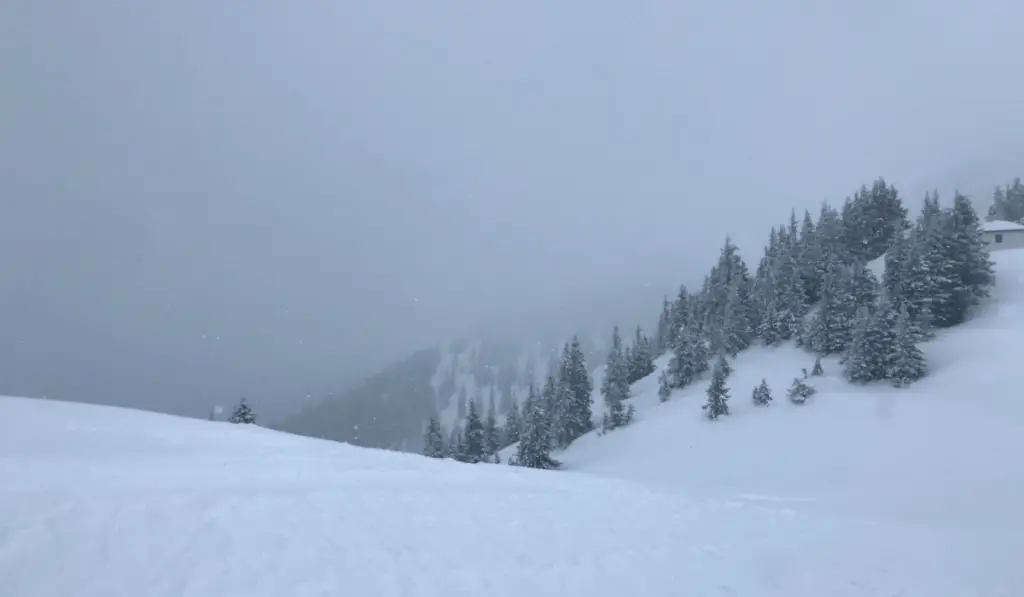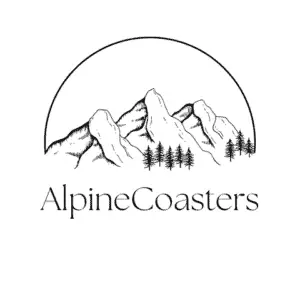Have you ever been on the slopes and due to heavy clouds or snow everything appears white?
If the answer is yes, then you’ve experienced something known as flat light.
If you’ve been skiing for long enough then this is fairly common but for beginners, this can be an overwhelming experience.
In this article, we explain what flat light is, how to ski in it and the type of goggles you need to deal with these low-light conditions.
Contents
- What is Flat Light in Skiing?
- How to Ski in Flat Light Conditions
- Which Goggle Lens is Best for Flat Light?

What is Flat Light in Skiing?
Flat light in skiing occurs in overcast or snowing conditions when sunlight does not reach the ski slope. Because of this, there is little to no contrast making it very difficult to see uneven surfaces or obstacles ahead of you.
If you’ve ever been in a situation like this you’ll know that the entire slope looks like a sheet of white paper.
It’s almost impossible to distinguish bumps and uneven surfaces making skiing and snowboarding that much harder.
This situation is made even more difficult if you’re wearing the wrong lenses.
In these conditions, you need as much light as possible to pass through to your eyes so that you can see where you are going.
As a beginner, you might be tempted in these low-light conditions to not use goggles at all.
But this isn’t a good decision because flat light conditions often occur when there is heavy snow and wind.
This means that not only is there not enough light to see where you are going, but sometimes the conditions are such that you still need to protect your eyes.
That is why it is still important to wear goggles in flat light conditions. Using the correct lens will improve contrast and visibility.
How to Ski in Flat Light Conditions
If you happen to be caught in flat light conditions that doesn’t have to mean the end of your day.
Below are some helpful ski tips you can use in flat light conditions:
- Lower your stance – lowering your stance lowers your centre of gravity making it less likely you’ll fall if you come across uneven terrain.
- Use a good flat light lens – in flat light conditions you’ll want to avoid glasses. Instead, use goggles with a high VLT lens and either a rose or yellow tint. This type of lens will allow more light to reach your eyes, improving the contrast and your ability to see where you are going.
- Slow down and make lots of turns – this applies to everyone but especially beginners. Slowing down gives you more time to react to moguls and uneven terrain. And if you do happen to fall, the lower speed will make you less likely to come out of your skis or injure yourself.
- Avoid ski bowls and wide open areas – these parts of the slopes tend to be featureless in flat light conditions making it incredibly difficult to see any bumps or obstacles.
- Ski near trees or lift towers – trees and lift towers help to provide contrast and orientation, making it easier for you to see in which direction the run is going.
The video below provides some useful, practical advice for skiing in flat-light conditions.
Which Goggle Lens is Best for Flat Light?
The best goggle lens for flat light skiing is a lens with a VLT of 50%+ and a lens with a light rose, amber or yellow tint.
Below we go into more detail on what exactly VLT and lens color have to do with skiing in flat light conditions.
Flat Light – Variable Light Transmission (VLT)
If you’re going to be skiing in flat light conditions you’ll want to make sure you have a lens with high variable light transmission.
Variable light transmission or VLT refers to the amount of light that passes through the lens. VLT is measured on a scale of 0% – 100%.
Lenses with a low VLT do not allow a lot of light to pass through making them perfect for blue-bird or bright sunny days.
High VLT lenses allow more light to pass through making it easier to see in these low-light conditions.
These are the type of lenses you’ll want to be wearing in flat light conditions.
Flat Light – Lens Color
Based on my experience and other sources, most people prefer a rose or yellow lens when skiing in flat light.
These lens colors help improve the contrast in low-light skiing making it easier to see uneven surfaces.
Yellow or rose lenses already have a high VLT so that box is ticked. As to which color is best, well that often comes down to personal preference.
We recommend trying out the different color lenses to see which ones you prefer.
Flight Light – Lens Technology
In addition to VLT and lens color, modern lens technology also plays an important role in improving visibility in low-light conditions.
This type of lens technology, such as ChromaPop™ (Smith) and Prizm (Oakely), enhances color and contrast in all light conditions.
You’ll pay a bit more for these lenses but if you’re looking for high-quality ski goggles that will help you see in flat light conditions then consider one of these brands.
Final Thoughts
Mountain conditions are unpredictable so there is a good chance you’ll be caught in some flat light conditions.
If you happen to find yourself in this situation, then having the correct gear will not only make the experience more enjoyable but will also make it much safer.
In flat light conditions, the inability to judge the terrain can be dangerous and result in possible injury.
You can prepare for these situations by checking the forecast weather conditions and carrying either a separate pair of low-light goggles or a lens replacement if the conditions change.

